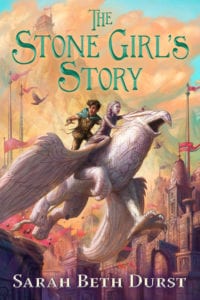Book Review: ‘The Stone Girl’s Story’
Reviewed by Jeffrey Sanzel
“No matter what the story is, it’s all under the same sky.”

In her new young adult novel, “The Stone Girl’s Story,” Sarah Beth Durst has created a genuinely unique universe where those of flesh and blood (human and animal) coexist with animate stone creatures. It is a fascinating conceit and she has populated a world where often the creatures of stone have more humanity and self-awareness than their living counterparts.
The book is an original take on the traditional Wizard of Oz-style journey. In this case, Mayka, a stone girl, leaves the mountain to rescue her stone companions. What has shifted in the secure retreat is that Father (the Stone Mason who carved them) has passed away and their markings have begun to fade. The markings are at the center of the story as they are at the heart of their stories: It is these designs that not only give them being but also individuality and purpose.
The carved designs define them. For instance, the cat, Kalgrey, is engraved with “This is Kalgrey the cat. Sharp of tongue and claws, nimble of paws and mind. She climbed the top of the chimney and scolded the sun and then slept when it hid, frightened behind a cloud.” But there is more to Kalgrey: as she “curl[s] up every night by the door to watch over [them] … and keep the rats out of the chicken feed.” Durst captures these simple yet complicated souls in an eloquently poetic prose.
The book opens with a touching scene where Mayka is visiting a stone turtle who is no longer aware, as its marks have faded. The poignant tableau casts the shadow of what is happening and possibly what is to come. Her feelings toward her comrade establish who she is and what she is willing to risk to help this intimate community. Even though she cannot smell the flowers or shed tears (though she ponders what both would be like), she has a heart that is full of truth, honesty and compassion.

The stone Badger, now the oldest of the group, gives Mayka a blessing of sorts to send her on: “We are family. No blood binds us, for we have no blood, but we are bound by time and love. You will carry our love and hope with you to the valley, and it will strengthen you.” With this kind benediction, she leaves the protected Eden (where the stone animals feed and care for the real ones) and embarks on an odyssey down the mountain, into the valley, and finally to the town of Skye, where her goal is to find a stonemason to return with her and restore the patterns.
She is accompanied by two stone birds: the cautious Risa and the outgoing chatterbox Jacklo, who provides a wholly enjoyable mix of on-the-nose as well as deadpan humor. On their way, they are joined by a whimsical 2-foot-high stone dragon, Siannasi Yondolada Quilasa — called Si-Si—who deeply yearns to find her purpose — her “story.”
“The Stone Girl’s Story” has a rich and accessible mythology, complete with the lore of how the first Stone Mason brought his work to life as well as a historical Stone War that devastated the society. It is this event that had far-reaching repercussions: Stone Masons went from revered to feared to something in-between, now sequestered in the Stone Quarter. (The departed Father turns out to have had a very important connection to the war and all that ensued.)
Mayka and her troupe become embroiled in the events surrounding the annual Stone Festival. It is here that they meet and join forces with a young man, Garit, who is apprenticed to Siorn, the stone mason. Siorn is a fully realized character, not merely an adversary and a villain; he is a dimensional human with his own deep-rooted beliefs (both dangerous and misguided).
Without revealing too much of the tightly woven and engaging plot, it is the challenges the quartet face and how they overcome them that encompasses the latter half of the adventure. Mayka and her mountain friends truly learn what it is to be “other” — both from humans and other stone creations.
While not illustrated, Durst paints in language so vivid that the tale leaps off the page. Her images are visceral. Prior to Mayka’s first experience in the city, her life has been pastoral. Now, she is overwhelmed by Skye’s tumult; the account leaves the reader in the midst of the chaos and is truly breathtaking: “Now that she was within the city, it seemed … too full, too much. This deep in the forest of people, she couldn’t see anything but more people.” Even gazing up, “the sky was only a thin streak of blue. But the roar of the city felt muffled, smothered by the walls.”
She takes in the surroundings and the inhabitants:
“They came in all shapes and sizes, wearing more colors than she knew existed: a boy in a more-orange-than-a-pumpkin hat, a woman wearing a dress of feathers, a man with a bare chest but a many-layered skirt with tassels dangling all around. Between them were stone creatures, plenty of them. Stone rats scurried through the street with rolls of paper strapped to their backs, carrying messages. A stone squirrel with a bucket around its neck was scrambling across the face of a building as it cleaned the windows. Other stone creatures — bears, wolves and bulls, some crudely carved and others exquisitely detailed — blocked the entrances to the fancier houses, acting as guards.”
Durst ponders what it is to be alive and the wonders of the natural universe (epitomized in a memorable depiction of butterfly migration). Time is relative and it is in how you use it, and she presents this in the contrast between mountain and valley worlds.
The book offers several important lessons without every overstating them or sacrificing the engaging narrative: That joy in living is freedom and we must be able to choose our own destinies … and that, ultimately, we have the ability not just to create but to change our own stories. Furthermore, it is not what we ask of others but of ourselves — and that our own untapped resources can be our deliverance. The powerful message is elegantly and honestly presented in a way that young people of all ages can comprehend the significance of this lesson. Like in “The Wizard of Oz,” the heroine seeks help but finally realizes she had the power within herself all along.
And, most of all, the book reminds us that “we make our stories our own.” It is that “everyone [has] a story that matter[s] most to them, that define[s] them.” “The Stone Girl’s Story” is that we are all need and hope — but, above all, we are potential. “I am the hero of my own story.” And that is a wonderful truth in a truly enchanting novel.
Sarah Beth Durst is the award-winning author of 15 fantasy books for kids, teens and adults. The master storyteller lives in Stony Brook with her husband, her children and her ill-mannered cat. Recommended for ages 10 to 12, “The Stone Girl’s Story,” published by Houghton Mifflin Harcourt/Clarion Books, is available online at Barnes & Noble and Amazon. For more information, visit www.sarahbethdurst.com.







